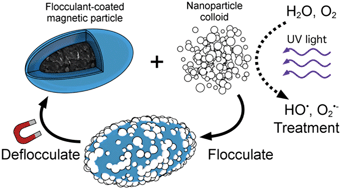Magnetic flocculation for nanoparticle separation and catalyst recycling†
Abstract
Nanoparticles are heavily researched for environmental applications, such as photocatalytic water treatment, however practical separation of nanoparticles from colloidal dispersions remains a critical challenge. Here, we demonstrate a new approach to nanoparticle recovery, combining the advantages of flocculation with magnetic separation to enable simple collection of non-magnetic nanoparticles. Flocculant polymers were coated onto magnetic nanoparticles (Fe3O4@SiO2) to prepare reusable magnetic flocculants (MFs). When added to colloidal nanoparticle dispersions, MFs aggregate with the suspended nanoparticles to form magnetically responsive flocs, which upon separation can be reversibly deflocculated for nanoparticle release, and reused in a closed loop process. High separation efficiency was attained in a variety of nanoparticle suspensions, including Au, Ag, Pd, Pt, and TiO2, stabilized by different coatings and surface charge. The MFs were shown to be recyclable for photocatalytic treatment of naphthenic acids in oil sands process-affected water (OSPW) and selenate in flue gas desulfurization wastewater (FGDW). Magnetic flocculation thus represents a general platform and alternative paradigm for nanoparticle separation, with potential applications in water treatment and remediation of nanoparticle pollution. Furthermore, given that flocculant chemicals can be recovered and reused in this process, magnetic flocculation may also serve as an environmentally sustainable solution to conventional flocculation challenges.

- This article is part of the themed collection: Nanomaterials in air


 Please wait while we load your content...
Please wait while we load your content...